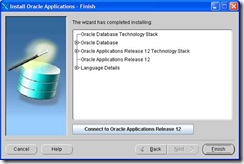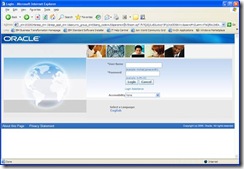Wednesday
Going to bite the bullet....
So why am I doing it now? Work is pretty slow at the moment and will be for the foreseeable future... So instead of going stir crazy in my cubicle its something to keep me busy. Its a good way to review all the features of Oracle and this is where I see the real value of an OCP.
Tuesday
Walk through – Installing R12
The following article describes at a medium-high level how to install an R12 Vision Demo environment. Each OS has different pre and post requirements so be sure to read the metalink notes specific for your environment.
The article has two sections, the first lists relevant documentation and Metalink notes. The second section provides installation steps with screenshots of each screen that you will see during the installation process. However, I didn’t detail every pre or post requirement performed because there are differences for various OSes and it could get confusing. I’ll mention the following a few times throughout this article: Make sure you follow the Metalink note for your OS.
Documentation Notes and Links:
Metalink Notes:
Linux x86 402310.1
Linux x86-64 (64-bit) 416305.1
HP-UX Itanium 402307.1
HP-UX PA-RISC 402308.1
IBM AIX 402306.1
Microsoft Windows 402311.1
Sun Solaris SPARC 402312.1
405565.1 – R12 Installation Guidelines. Contains upto date information which may not be included in the Rapid Install Guide.
549389.1 - Oracle Applications Release Notes, Release 12.0.4 – Contains information on latest Rapid Install patch.
Installation Steps:
- Create a user account. I will be using the account oravis which will be a member of the dba group. Some installations use two accounts, applmgr or appl<sid> for the E-Business Suite files and ora<sid> for the database account.
- Review your operating system specific metalink note and verify all OS requirements are met. This document can seem overwhelming if you are new to Oracle/E-Business Suite so take your time and read through it. In most cases, you’ll just need to summarize this note for your system administrator. Some of the key areas are:
- Confirm your operation system is supported.
- Confirm required patches/packages are applied.
- Confirm kernel settings.
- Modifying various configuration files depending on platform. (/etc/hosts, limits.conf, etc..)
Each type of OS has different requirements, so make sure you review the appropriate metalink note (above) If you don’t have a system administrator, feel free to ask me questions. I’ll gladly help as best I can.
- Download R12 from Oracles eDelivery site, http://edelivery.oracle.com. Unzip the files to create your stage directory. You will need about 75GB of space.
Note: You don’t have to download every archive listed. You only need to download upto the documentation files, which for version 12.0.4 is around 26 archives (Solaris version).
- Download the latest Rapid Install patch as described in Note 549389.1. At the time this article was written the latest patch is 6919017. Uncompress this file within your stage directory. Ie.
- $ cd Stage
$ unzip –o p6919017_R12_GENERIC.zip
- $ cd Stage
- Welcome Screen
cd <Stage DIR>/startCD/Disk1/rapidwiz and launch the program rapidwiz:

Click on Next.
NOTE: The Rapid Install Wizard for the unix or linux platform needs access to an X server. If your not executing rapidwiz from a local xterm on the server then you must export your display to a server in which you have X access. I use Hummingbird Exceed so I can view the GUI on my laptop but there are many other options available.
For Exceed there are two ways to do this. The easiest way would be to use Exceeds Client Wizard to create a connection. This will automatically set your DISPLAY properties.
The other option would be to launch Exceed manually, login to your server and set the DISPLAY variable to that of your PC’s IP address.
- Wizard Operation Screen

Select “Use Express Install” and click on Next. When Express Install is selected you will not be prompted for additional information which will allow you to customize the installation. Since this will be used for self training, it’s a perfect start.
- Oracle Configuration Manager

Select Decline followed by the Next button.
- Express Configuration Information
Some of the fields below will be pre-populated. For those that aren’t fill them in.

Once you click on Next , Rapid Install Wizard will perform a system check.
- System Check Status

- Pre-Install Checks
Once the system check is complete you will be presented with a summary window. If any of the checks failed you can click on the red X and it will show you why. If all the checks are successful you will see the following screen:

When you click on Next the application will begin to install:

- Post-Install Checks
Once the install is complete the following window will appear. If you see any red X’s, click on them to get more information on the error. If everything was successful you will see the following window:

If everything was successful click Next
- Finish

The install is complete. Click on the Finish button to exit the Rapid Install Wizard.
- Verify
You can either click on “Connect to Oracle Applications Release 12” button in step 12 or launch a web browser manually. For the URL enter:
http://<servername>.<domain_name>:<Port number>/OA_HTML/AppsLogin
<Port Number> is derived from the Port Pool we choose in Step 8 prefixed by the value 80. Since we choose 50 for the port pool, the port number above would be 8050. The following screenshot is of the login page:

- Post-Install Tasks
Each OS may have different post-installation tasks. For instance, if you installed the Vision Demo environment such as we have above, then you need to submit a concurrent request to build DQM indexes. In the case of Linux (OEL5 REL5), you will have to upgrade the 10.1.3 application server to 10.1.3.3
If you have gotten this far, then you have successfully installed an R12 Vision demo environment. If you have any questions, feel free to ask.
VMware/Windows Tip: Mounting a stage directory
Here is a quick tip on how to mount Windows shares in a Linux environment. I mention this as a VMware tip because I see alot of people transferring source files to their VMware image by launching a browser within the vm or via ftp.
If the product your installing is fairly large this could inflate your vmware image, taking up more room on your hard drive. If you take snapshots or back them up, then thats space can add up. As well for products like R12, the stage directory is just under 40GB. Thats not something your going to want to store inside your VM.
I have one directory on my system which contains all the products I have downloaded including R12 for Linux, various versions of Oracle for different OS’s and patches. I share out this directory via Windows (right click on the folder name followed by “Share…” (Vista)) and mount it within the virtual machine by executing the following command:
mount -t cifs //192.168.0.100/R12 -o username=dave,password=mypass /mnt/Stage
Note: make sure /mnt/Stage is an empty directory otherwise the mount will fail and that your kernel supports CIFS. The username and password above are that of my Windows account. //192.168.0.100/R12 would be my laptops IP address and the Windows share name.
Monday
ORA-00600 during adcfgclone.pl dbTier
ORA-00600: internal error code, arguments: [skkxerrp], [skkxdllload],
[SlfFopen], [/u001/CRP1/oracle/crp1db10g/10.2.0/plsql/nativelib/d66/STANDARD__SYS__S__647.so], [No such file or directory], [], [], []
A search of metalink will result in a single hit, NOTE:382767.1. The note mentions two possible solutions:
- Setup native PL/SQL before cloning
- Modify the rapid clone template file to remove two plsql parameters.
When I looked at the template file ($ORACLE_HOME/appsutil/template/afinitdb_102.ora), I noticed that by default the parameter plsql_code_type gets reset to INTERPRETED. I'm not sure why this happens, I would have assumed it would be set to the production value of NATIVE. So instead of performing the solutions described in the metalink note I change plsql_code_type to native and re-executed adcfgclone.pl dbTier, which this time completed without error.